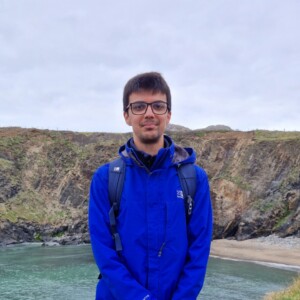
Raheem Butt
University of Birmingham
Project
Tetrapod Diversity in the Purbeck Limestone Group of England: Implications for Jurassic-Cretaceous Faunal Turnover
Supervisors
- Prof. Richard Butler
- Prof. Kirsty Edgar
- Prof. Susannah Maidment
- Dr. Luke Meade
- Dr. Chris Reedman
PhD Summary
The Jurassic–Cretaceous (J/K) transition is an interval of important faunal turnover in Mesozoic terrestrial ecosystems, occasionally hypothesized to represent a poorly understood mass extinction event. However, our understanding of faunal change has been limited by the generally poor global record of the latest Jurassic and earliest Cretaceous fossils. Rocks of the Purbeck Limestone Group crop out along the eastern end of the Jurassic Coast World Heritage Site in Dorset, UK, and date to the latest Jurassic to earliest Cretaceous. They formed in marginal and shallow marine environments, and have yielded more than 60 species of turtles, lepidosaurs, crocodilians, pterosaurs, dinosaurs and mammals. This diversity makes the Purbeck perhaps the best site globally to examine tetrapod faunal change during the J/K transition.
This project aims to examine large-scale patterns of tetrapod community structure and faunal change throughout the Purbeck Limestone Group. Suitable horizons will be systematically sampled both vertically through the stratigraphy, and laterally at different outcrops along the coast and inland. Vertebrate microfossils will be extracted via screenwashing, identified, and combined with historical data to assess the diversity and ecological structure of Purbeck ecosystems, and their stability and variation through time. A re-examination of historically collected fossil material will also be undertaken using the collections of the Natural History Museum in London and CT scanning approaches. All these data will be drawn together and combined with those from Late Jurassic (e.g. Morrison Formation, USA) and later Early Cretaceous (e.g. Wealden Group, England) ecosystems, allowing us to better understand changes in community composition and ecological diversity through the J/K transition.
Previous activity
Prior to starting my PhD, I undertook an integrated master’s in Geology at University College London. My specific interest in vertebrate palaeontology stemmed from my final year research project, which looked at quantifying the completeness of the global fossil record of crown-group frogs using character completeness metrics. After graduating from UCL in 2023, I spent a year working in retail before starting my PhD here at Birmingham.
Why did you choose doctoral research?
My final year research project truly cemented my desire to pursue palaeontological research as a career path, because it instilled within me a deep curiosity to better understand the processes and patterns of vertebrate evolution within the Mesozoic, and to apply fossil and anatomical data to elucidate palaeoecological and evolutionary trends across geological time. But it was ultimately the advice, support and strong words of encouragement from my project supervisors (Prof. Paul Upchurch and Prof. Phillip Mannion) and other academic researchers whom I met during my undergrad (e.g. Dr. Marc Jones and Prof. Susan Evans), that really inspired me and gave me the confidence and motivation to actually pursue a PhD.
Why did you choose CENTA?
One of the main reasons why I chose CENTA is because of the strong connection between the universities and research institutions within the CENTA consortium (in my case the Natural History Museum (NHM) and Jurassic Coast Trust). Through this I am able to benefit from the facilities and resources provided by both the university and partner institutions (e.g. the Earth Sciences Library and CT scanner at the NHM), and collaborate with multiple researchers across different departments and disciplines. Another aspect which interested me about CENTA was its multidisciplinary training programme, which allows PhD students to develop a number of very useful transferrable skills beyond those you might necessarily acquire through just your research project alone (e.g. scientific engagement and research management). These skills will be incredibly useful as I look to build a career as an academic researcher.
Future plans
Through my PhD I hope to develop a range of palaeobiological skills, from microvertebrate sampling and processing to CT scanning, segmentation and 3D visualisation. Acquiring such proficiency in computational, field- and lab-based work would be invaluable in supporting my future career prospects, providing me with a broad subject-specific skillset from which I can then specialise further as an academic researcher. Upon the completion of my PhD, my plan is definitely to stay within academia and continue my research looking at the evolution and diversity of Mesozoic tetrapods, whilst also undertaking some sort of teaching role as well. Oh…. and plenty more fieldwork too!
